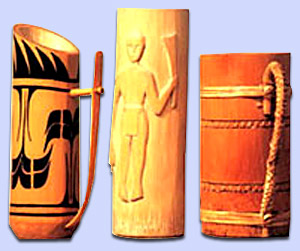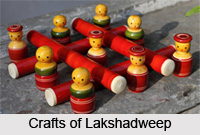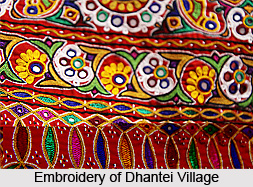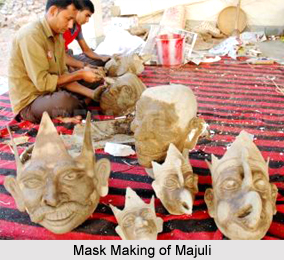 Arrays of crafts are produced in Majuli. It is the world`s largest fresh water river island, is located in the Indian state of Assam. The people residing here comprise of a wide mix of tribals such as the Kacharis and the Ahoms, the Deori tribes and the Mishing tribes. The beautiful island reflects a perfect combination of diverse cultures, natural beauty and art and craft. Some of the important crafts of Majuli have been discussed below:
Arrays of crafts are produced in Majuli. It is the world`s largest fresh water river island, is located in the Indian state of Assam. The people residing here comprise of a wide mix of tribals such as the Kacharis and the Ahoms, the Deori tribes and the Mishing tribes. The beautiful island reflects a perfect combination of diverse cultures, natural beauty and art and craft. Some of the important crafts of Majuli have been discussed below:
Wood Carving
Wood carving is one of the most exquisite forms of art work of Majuli. Some of the artefacts comprises of beautifully carved wood pieces used for decorating the entrance door of every quarter of the Sattras, monasteries of Assam, decorative masks for deities, animals that adorn the walls of the Sattras, various utensils like Xarai, Bota used for offering betel nuts to the guests assembled for some religious purpose and Thoga utilized for keeping religious books. Presently, the artisans have drifted from their traditional craftwork and have made a shift towards creating more commercialised products to earn their livelihood. They mostly focus on creating decorative items, such as, various models of Majuli, images of animals and birds etc. These are all carved out of wood. Another significant wood work of Majuli is the wooden boxes made for household purpose. Few of these are known as Hatani-pera, Bora-pera and are chiefly used for keeping clothes and other valuable objects.
Manuscript Making
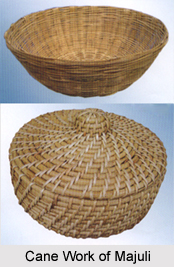 Manuscript making is another remarkable form of craftwork of Majuli that stand unique in entire India. In the olden days before paper was discovered and used on a huge scale, the religions leaders of the Sattras utilized the papers for writing. These were produced from the bark of the plants. They used naturally made ink prepared from the Keheraj stems. These were then coloured by natural colourants like Hengul and Haital. Several ancient manuscripts have been preserved in different Sattras. A pictorial manuscript Hosti Vidyamava written on elephant conservation has been preserved in Auniati Sattra. This traditional skill of manuscript making has been handed down from one generation to another and is presently practised by a group of enthusiastic and gifted craftsmen.
Manuscript making is another remarkable form of craftwork of Majuli that stand unique in entire India. In the olden days before paper was discovered and used on a huge scale, the religions leaders of the Sattras utilized the papers for writing. These were produced from the bark of the plants. They used naturally made ink prepared from the Keheraj stems. These were then coloured by natural colourants like Hengul and Haital. Several ancient manuscripts have been preserved in different Sattras. A pictorial manuscript Hosti Vidyamava written on elephant conservation has been preserved in Auniati Sattra. This traditional skill of manuscript making has been handed down from one generation to another and is presently practised by a group of enthusiastic and gifted craftsmen.
Mask Making
The art of mask making is a unique feature of Majuli. The masks are mostly used by artists for enacting religious stories in the form of drama. The masks are made of bamboo with the combination of cloth and paper. It makes it lightweight and the actors can carry it with ease. The different types of masks made in Majuli are sometimes small and big. These are replicas of gods and goddesses, demons, birds, animals, etc. The masks at times cover only the mouth of the actor known as Mukh-mukha or the whole mouth known as Suti-mukha or Lotokai Mukha. Occasionally it also covers the whole body known as Soo Mukha. The skeleton is first made with bamboo and then covered with paper or cloth. Then the required shape and contours are given by using mud. At last the mask is coloured with natural colourants or home made colours.
Pottery
The art of pottery is an age old tradition that depicts the mastery of the Kumar community of the Majulis. They mainly reside in the Salmora village. Kalah, Tekeli, Vabuki, Mala, Nadiya and others are some of the different types of pots that depict the proficiency of the ace artisans. Other than these the craftsmen are also expert in making modernized crafts like flowerpots, toys, earthen statues, etc.
Handloom
Handloom comprises an important sector of Majuli. The craftsmen enjoy a special place in the state particularly for their unique and exquisite Mirizim and Erhee or Endee shawls. The Mishing community possess expertise in making Miriam while Erhee rearing, spinning and weaving are mostly practised in other lower Assam districts. Traditional dresses like Cheleng, Mekhala-Chadar and Shawls are produced in the looms of the weavers. The Mishing women have proficiency in weaving Ribi Gaseng used by women to cover the upper portion of the body, Mibu Galok, a stitched colourful cloth used for covering the lower portion of the body.
Bamboo and Cane Work
The artisans of Majuli are also skilled at bamboo and cane works. They make various types of baskets like saru-pachi, bor-pachi, nichuka kharahi, kharahi, dala etc., household furnitures like beds, chair, table, murha, a stool made from delicately knitted bamboo sticks, fishing equipments such as polo, ubhati, juluki, ghani, sepa, caloni, hukuma, khoka, pocha etc. The craftsmen also have expertise in making decorative modern crafts for interior decorations.
For several years Majuli has attracted the attention of international and domestic tourists for its sublime natural beauty as well as for its rich art and craftwork of the artisans.



